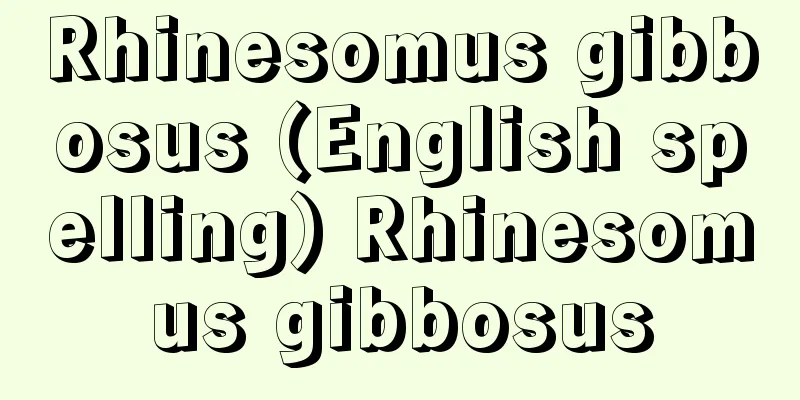Monster - Kaiju

|
Beasts with strange or mysterious shapes or ecology. Although it is not an academic term, they can be roughly divided into the following four categories: (1) Ancient animals, mainly dinosaurs. (2) Imaginary animals. (3) Mysterious animals that are said to exist in reality. (4) Animals that appear in science fiction and movies. [Kaji Tatsuo] Ancient animals, mainly dinosaursThe reptilian dinosaurs that flourished in the Mesozoic era had huge sizes and strange shapes that were quite different from modern mammals. Furthermore, their existence was only confirmed as fossils, so their existence puzzled people and they came to be called monsters. Even today, these animals, including extinct animals from the Cenozoic era such as stegodonts, meritheriums, and mammoths, are often called monsters. [Kaji Tatsuo] Fantasy AnimalsMonsters can be divided into those created from Greek and Roman mythology, the Bible, legends, and oral traditions, and those created by glimpses of real animals, hearsay, and fantasy. The centaur in Greek mythology is half human and half horse, the gorgon has the appearance of a human woman, but has bird wings and claws, and hundreds of snakes for hair, and the griffin is a monster that is a mix of an eagle and a lion. There are some differences in appearance and the legends surrounding it, but one that is widely circulated around the world is the dragon. There are also many monsters in China and Japan, such as the nue, which has the head of a monkey, the body of a tiger, and the tail of a snake, but is a winged bird that is said to cry like a baby, and the kappa, a water sprite. However, some of these monsters are based on real animals. For example, it is said that the centaurs came from people who had no knowledge of horses seeing humans riding horses, and the Nue came from hearing the cry of the thrush. There is also a strong suspicion that mermaids and the giant creatures that live in the Norwegian seas, the Krakens, are imaginary monsters that were created based on real animals. It is conceivable that mermaids were created based on sea cows such as dugongs and manatees, and Krakens were created based on the association of giant squids with various imaginary embellishments added. [Kaji Tatsuo] Mysterious animals that are said to existIn the past, when transportation was underdeveloped and photography did not exist, knowledge of animals living in faraway lands was based on the incomplete memories of witnesses or on embellished stories, so many were perceived as monsters. Rhinos were depicted with turtle shells on their backs, giraffes were simply long-necked horses, and even in the 20th century, pandas were depicted as wild animals with ferocious faces and hunting teams were dispatched. However, in today's world, where animal research and studies have developed rapidly, it is said that new species of mammals will no longer be discovered. However, among them, there are mysterious monster animals that are said to still be undiscovered. The Himalayan yeti, which became a hot topic when a British expedition discovered its footprints in 1951, is said to have a similar species in the forests of Canada, named Sasquatch. There are also rumors that it lives in the mountains of Hiba County, Hiroshima Prefecture, in Japan, and it is named Hibagon. Nessie is a giant monster said to be a dinosaur that lives in Loch Ness in Scotland, and quickly became a hot topic around the world after a photo that looked like it was captured in 1934. These mysterious animals are also called UMA (Unidentified Mysterious Animals). [Kaji Tatsuo] Sci-fi and movie monstersA completely imaginary monster created in science fiction and children's entertainment, especially in movies, but nowadays the word "kaiju" can refer to just that. In science fiction, the generic term "Bem" is used to refer to extraterrestrial space creatures, and since British author H. G. Wells created Martians in " The War of the Worlds" (1898), various space monsters have been created. The American film "King Kong," featuring a giant gorilla as the main character, marked the beginning of monster movies in Japan, but it was Tsuburaya Eiji's "Godzilla" (1954), which used special effects photography, that sparked today's monster boom in Japan. Since then, Tsuburaya Productions has created many monsters, mainly in the Ultra series, including "Ultraman," in which humans act inside stuffed animals, such as Garamon, Gomora, and Gorgos, and made them popular with children. In addition, the giant moth monster "Mothra," which was equally as popular as "Godzilla," and the "Gamera" series, a monster modeled after a turtle, were produced one after another, ushering in the golden age of monster movies. Monster movies went into decline after the late 1970s, but signs of a revival began to appear with the production of "Godzilla" in 1984 to commemorate the 30th anniversary of Godzilla's birth, and since the 1990s, monster movies including "Godzilla," "Mothra," and "Gamera" have been produced consistently. Overseas, Steven Spielberg's dinosaur movie "Jurassic Park" (1993), which made full use of computer graphics, and the SFX monster movie " Godzilla" (1998), a remake of "Godzilla ," were produced in Hollywood and became a hot topic. [Kaji Tatsuo] ``Mysterious Monsters and Mysterious Animals'' edited by Yoshida Kenichi (1964, Shinchosha) '' ▽ ``World Animal History, volumes 1 and 2, by H. Wendt, translated by Obara Hideo, Haneda Setsuko, and Ooba Saraaki (1974, Heibonsha)'' ▽ ``UMA: Mysterious Unidentified Animals'' by Saneyoshi Tatsuro (1976, Sports Nippon Newspaper Publishing Bureau)'' ▽ ``UMA (Unidentified Animals)'' edited by Komukai Masashi (1993, Gakken)'' ▽ ` `Jurassic Park: The Secret of the Dinosaurs Resurrected'' written by Wendy Larson and commentary by Tomita Kyoichi (1993, Holp Publishing)'' ▽ ``Chase the Mysterious Giant Beasts: A Thorough Investigation of the True Identity of the Unknown Animals, ``Hidden Animals'', written by Minamiyama Hiroshi (1993, Kosaido Publishing)' ' ▽ ``Search for Japan's Monsters and Mythical Beasts! --The Truth Behind the Unidentified Creature Encounters (1993, Kosaido Publishing)" ▽ "Jurassic Dinosaurs and Spielberg Guys" by David Allen, James Van Hise, Bob Hahn, and Douglas Diamond, edited and translated by Japan Mix (1993, Japan Mix)" ▽ "Encyclopedia of Mysterious Animals by Imaizumi Tadaaki (1994, Data House)" ▽ "Another-1: Godzilla Special Effects Collection --The Definitive Edition of Toho Monster Movies!! ' (1994, Natsume Publishing)' ▽ 'The Great Reprint of the Great Illustrated Monster Encyclopedia' by Kinjo Tetsuo and Otomo Shoji (1997, Asahi Sonorama)' ▽ 'The Great Illustrated Monster Encyclopedia' by Motoyama Sho (1997, Green Arrow Publishing)' ▽ 'Director Gamera's Diary' by Kaneko Shusuke (1998, Shogakukan)' ▽ 'What is Godzilla?' by Peter Musoff, translated by Ono Kosei (1998, Kodansha)' ▽ 'Godzilla Invades!! - A Reintroduction to Toho Monsters and Sci-Fi Special Effects Films' by Sakai Yoshito and Akita Hideo (1998, Longsellers)' ▽ 'The Atomic Monster Appears! --The secret of the birth of GODZILLA and the future of Japanese special effects software (1998, Footwork Publishing)" ▽ "Godzilla "Super" Encyclopedia -- Godzilla vs. GODZILLA, edited by the GODZILLA Fan Club (1998, Hiten Publishing)" ▽ "Dictionary of Imaginary Beasts, by Jorge Luis Borges and Margarita Guerrero, translated by Yanase Naoki (1998, Shobunsha)" ▽ "Monster Mythology Theory, by Yamoto Masayuki (1998, Seikyusha)" ▽ "Encyclopedia of Movie Monsters -- Godzilla, Gamera, Mothra, Yamato Takeru (1999, Poplar Publishing)" ▽ "Forty Years of Research on Japanese Special Effects Films by the Original Monster Boy, by Takeuchi Hiroshi (2001, Jitsugyo no Nihon Sha)" ▽ "The Discovery of Dinosaurs" by Edwin H. Colbert, translated by Ikuo Obata and Ryuju Kameyama (Hayakawa Bunko)" ▽ "Dinosaurs in America" by Takayuki Tatsumi (Chikuma Shinsho) ▽ "My Monster Days: My 100 Years of Eiji Tsuburaya" by Akio Jissoji (Chikuma Bunko) ▽ "Dinosaurs Come to Life: An Introduction to Digital Paleontology" by Kyoichi Sasazawa (Chuko Shinsho) ▽ "Carey Miller: A Dictionary of Monsters and Mysterious Beasts (1974, Pan Books Ltd., London)" [References] | | | | | | | | | | |Source: Shogakukan Encyclopedia Nipponica About Encyclopedia Nipponica Information | Legend |
|
奇怪な、あるいは不思議な形体や生態の獣。学術的なことばではないが、だいたい次の四つに分けられる。(1)恐竜を中心とする太古の動物。(2)空想上の動物。(3)実在するといわれる謎(なぞ)の動物。(4)SFや映画に登場する動物。 [梶 龍雄] 恐竜を中心とする太古の動物中生代に栄えた爬虫(はちゅう)類の恐竜は、現代の哺乳(ほにゅう)類の動物とはかなり相違した巨大さと不思議な形をもっていた。またその生存が確かめられるのは化石としてだけであったから、その実存が人を不思議がらせたため、怪獣とよばれるようになった。新生代に入ってからの絶滅した動物、ステゴドンゾウ、メリテリウム、マンモスゾウなども含めて、いまでもこれらの動物を怪獣とよぶことも多い。 [梶 龍雄] 空想上の動物ギリシア・ローマ神話、聖書、伝説口碑などでつくられた怪獣と、実際の動物の瞥見(べっけん)や伝聞に空想を加えてつくりあげられた怪獣とに分けられる。ギリシア神話のケンタウロスは上半身が人間、下半身がウマであるし、ゴルゴンは人間の女の姿をしながら、鳥の翼と爪(つめ)をもち、髪は何百匹というヘビ、グリフォンは鷲(わし)と獅子(しし)の入り交じった怪獣である。形体やまつわる伝説に多少の相違はあるが、世界中に広く流布されているものに竜(ドラゴン)がある。中国、日本にも怪獣は多く、鵺(ぬえ)は首はサル、体はトラ、尾はヘビであるが、羽をもつ鳥で、赤子のような声で鳴くといい、河童(かっぱ)もまた怪獣の仲間に入れていいだろう。しかしこれらの怪獣のなかにも一部現実の動物をよりどころにしているものもある。たとえばケンタウロスはウマを知らない民族が乗馬の人間を見たことから、鵺はトラツグミの鳴き声を聞いたことからだというようなこともいわれている。人魚(マーメイド)やノルウェーの海に住む巨大生物クランケンは、この実在の動物から考えられた空想の怪獣という疑いも濃い。人魚は海牛のジュゴンやマナティーから、クランケンは大イカの連想にさまざまの空想脚色が付加されたとも想像できる。 [梶 龍雄] 実在するといわれる謎の動物交通機関も未発達で、写真なども存在しなかった往時は、遠国に生息する動物に対する知識は、目撃者の不完全な記憶だったり、また潤色の強い話だったりしたために、多くは怪獣として受け取られていた。サイがカメの甲らを背負っていたり、キリンは単に首の長いウマだったりしたし、20世紀に入っても、パンダなどは猛獣とされて凶悪な様相の顔が描かれ、猛獣狩り隊が派遣されたりした。だが動物の調査と研究が急速に発展した現代では、もはや哺乳動物の新種発見などはないだろうといわれている。しかし、そのなかにあって、いまだに未発見だといわれている謎の動物の怪獣もいる。1951年イギリスの探検隊に足跡を発見されたころから急速に話題になったヒマラヤの雪男(イェティ)は、同類がカナダの森林地帯にサスカッチと名づけられて存在するともいう。日本でも広島県比婆(ひば)郡の山中にいるという噂(うわさ)もあり、ヒバゴンと名づけられている。ネッシーはスコットランドのネス湖に住む恐竜ともいわれる巨大怪獣で、1934年写真にそれらしい像が収められたとの噂から、急速に世界中の話題になった。なお、これらの謎の動物はUMA(ユーマ)(Unidentified Mysterious Animal=未確認動物)ともよばれている。 [梶 龍雄] SFや映画の怪獣SFや児童向けの娯楽物、とくに映画のなかでつくられた、まったくの空想の怪獣であるが、現今は怪獣というと、これだけをさしていうこともある。SFでは地球外の宇宙生物としてベムという総称が用いられ、イギリスの作家H・G・ウェルズが『宇宙戦争』The war of the worlds(1898)で火星人をつくって以来、さまざまの宇宙怪獣がつくられてきた。映画では巨大なゴリラが主人公のアメリカ映画『キング・コング』が怪獣映画の始まりであるが、今日の日本の怪獣ブームをよんだのは、円谷英二(つぶらやえいじ)の特殊効果撮影を使った『ゴジラ』(1954)で、以後、円谷プロは『ウルトラマン』をはじめとするウルトラシリーズなどで、主として、人間が縫いぐるみに入って演技する怪獣、ガラモン、ゴモラ、ゴルゴスなど、数多くの怪獣をつくりあげ、子供たちの人気ものにした。また「ゴジラ」と人気を二分する巨大蛾(が)の怪獣「モスラ」や、カメをモデルにつくられた怪獣「ガメラ」のシリーズなどが相次いで製作され、怪獣映画の黄金時代が築かれた。1970年代後半以降怪獣映画は衰退したが、1984年にゴジラ生誕30周年を記念した『ゴジラ』が製作されたのをきっかけに復活の兆しがみえはじめ、1990年代以降は「ゴジラ」「モスラ」「ガメラ」をはじめとする怪獣の映画がコンスタントにつくられている。海外では、コンピュータ・グラフィクスを駆使したスティーブン・スピルバーグの恐竜映画『ジュラシック・パーク』(1993)や、『ゴジラ』をリメイクしたSFXモンスター・ムービー『GODZILLA』(1998)がハリウッドで製作され話題をよんだ。 [梶 龍雄] 『吉田健一編『謎の怪物・謎の動物』(1964・新潮社)』▽『H・ヴェント著、小原秀雄・羽田節子・大羽更明訳『世界動物史』上下(1974・平凡社)』▽『実吉達郎著『UMA 謎の未確認動物』(1976・スポーツニッポン新聞社出版局)』▽『小向正司編『UMA(未知動物)』(1993・学習研究社)』▽『ウェンディ・ラーソン文、富田京一解説『ジュラシック・パーク――よみがえる恐竜のひみつ』(1993・ほるぷ出版)』▽『南山宏著『謎の巨大獣を追え――未知動物「ヒドン・アニマル」の正体を徹底検証』(1993・広済堂出版)』▽『宇留島進著『日本の怪獣・幻獣を探せ!――未確認生物遭遇事件の真相』(1993・広済堂出版)』▽『デヴィッド・アレン、ジェームズ・ヴァン・ハイス、ボブ・ハーン、ダグラス・ダイアモンド著、ジャパン・ミックス編訳『ジュラシックな恐竜とスピルバーグな野郎ども』(1993・ジャパン・ミックス)』▽『今泉忠明著『謎の動物の百科』(1994・データハウス)』▽『Another-1編『ゴジラ・特撮大全集――東宝怪獣映画の決定版!!』(1994・ナツメ社)』▽『金城哲夫・大伴昌司著『大復刻 怪獣大図鑑』(1997・朝日ソノラマ)』▽『元山掌著『怪獣大図鑑』(1997・グリーンアロー出版社)』▽『金子修介著『ガメラ監督日記』(1998・小学館)』▽『ピーター・ミュソッフ著、小野耕世訳『ゴジラとは何か』(1998・講談社)』▽『坂井由人・秋田英夫著『ゴジラ来襲!!――東宝怪獣・SF特撮映画再入門』(1998・ロングセラーズ)』▽『ナイト・ストカーズ編著『原子怪獣あらわる!――GODZILLA誕生の秘密と日本特撮ソフトの未来』(1998・フットワーク出版)』▽『GODZILLA愛好会編著『ゴジラ「超」事典――ゴジラ vs GODZILLA』(1998・飛天出版)』▽『ホルヘ・ルイス・ボルヘス、マルガリータ・ゲレロ著、柳瀬尚紀訳『幻獣辞典』(1998・晶文社)』▽『八本正幸著『怪獣神話論』(1998・青弓社)』▽『『映画怪獣大百科――ゴジラ・ガメラ・モスラ・ヤマトタケル』(1999・ポプラ社)』▽『竹内博著『元祖怪獣少年の日本特撮映画研究四十年』(2001・実業之日本社)』▽『エドウィン・H・コルバート著、小畠郁生・亀山龍樹訳『恐竜の発見』(ハヤカワ文庫)』▽『巽孝之著『恐竜のアメリカ』(ちくま新書)』▽『実相寺昭雄著『怪獣な日々――わたしの円谷英二100年』(ちくま文庫)』▽『笹沢教一著『恐竜が動きだす――デジタル古生物学入門』(中公新書)』▽『Carey Miller:A Dictionary of Monsters and Mysterious Beasts (1974, Pan Books Ltd., London)』 [参照項目] | | | | | | | | | | |出典 小学館 日本大百科全書(ニッポニカ)日本大百科全書(ニッポニカ)について 情報 | 凡例 |
Recommend
Aoyama Tadakado
1518-? A samurai from the Sengoku-Oda-Toyotomi pe...
Earth sciences - Chikyu kagaku (English spelling) Earth sciences
Earth science is a multidisciplinary science that...
Jasminum primulinum
…[Murata Gen]. … *Some of the terminology that me...
Thinning - Drought
It is the opposite of the final cutting in clear-...
Amphiaraus
In Greek legend, he was a hero and prophet of Argo...
Miller, WH
…On the other hand, the concept of crystal lattic...
Built-in - Uchikura
〘Noun〙 (also "Uchigura") 1. One of the t...
Takuba Kei - Takuba Kei
The first emperor of the Northern Wei Dynasty of ...
Tokyo [City] - Tokyo
The capital of Japan. It is located almost in the ...
Petal-shaped cross-section thread
...General term for artificially made fibers as o...
"The Jiaqing Ceremony"
…Five editions were made during the Qing dynasty:...
conjoined twins
...Also, because identical twins are produced fro...
Hydrofoil
...A ship that has hydrofoils attached to the fro...
Tolerance source - Kanyogen
... The property of a substance as an antigen is ...
Gingolic acid - Gingol-san
...The cause of severe allergic dermatitis caused...









